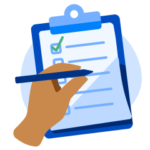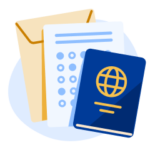The Student Direct Stream (SDS) enables eligible international students from 14 countries to expedite the processing of their Canadian study permit.

A study permit gives you the authority to stay in Canada. It includes important details about you, like:
- What is your reason for being in Canada
- What program level you are studying at
- The duration of your study program
- Whether you may work on- or off-campus while studying, or if there are any restrictions around working.
Most study permit applications made through the SDS are processed within 20 calendar days, although some can take longer.
To take advantage of faster processing, students must:
- Provide their biometrics (if necessary) as quickly as possible
- Meet all eligibility requirements
Note: A study permit is not a visa, and cannot be used to travel to or enter Canada. You may also need to obtain a visitor visa or an electronic travel authorization (eTA).
Read: “What’s the Difference Between a Study Permit and Student Visa?”

Who Is Eligible for the Student Direct Stream?
If you’re a legal resident of one of the following 14 countries, you may be eligible for faster study permit processing through the SDS:
- Antigua and Barbuda
- Brazil
- China
- Colombia
- Costa Rica
- India
- Morocco
- Pakistan
- Peru
- St. Vincent and the Grenadines
- Senegal
- The Philippines
- Trinidad and Tobago
- Vietnam
To be eligible, you must:
- Have a provincial attestation letter (PAL) from the province or territory you plan to study in
- Have an acceptance letter from a post-secondary designated learning institution (DLI)
- Live outside of Canada when applying
- Have proof of payment of first-year tuition
- Have a Guaranteed Investment Certificate (GIC) of C$20,635
- Have your most recent secondary or post-secondary transcript(s)
- Have a language test result demonstrating sufficient proficiency (see Language Test Results, below)
Depending on where you plan to study, and your personal circumstances, you may need to:
- Have a Certificat d’acceptation du Québec (CAQ) from the Ministère de l’Immigration, de la Francisation et de l’Intégration (if planning to study in Québec)
- Complete a medical exam before applying (if applicable)
- Get a police certificate (if applicable)
You may need to provide additional documentation, which can mean longer processing times. Please refer to your country’s specific visa office instructions, which you can obtain by selecting your country of residence from this menu.

Applying for a Study Permit through SDS? Here’s What You’ll Need.
Below you’ll find the specifics of certain documentation you may need for a study permit application made through SDS.
Provincial Attestation Letters
As of January 22, 2024, the majority of students who want to study in Canada must provide a provincial attestation letter (PAL) for their chosen study location. A PAL is an electronic certification confirming a student’s eligibility to apply for a study permit under a province’s quota. The requirement for a PAL doesn’t apply to master’s degree, doctoral degree, or K-12 students.
For more information on PALs and Canada’s updated international student policies for 2024, check out our FAQ blog.

Proof of First-Year Tuition Payment
Students may demonstrate proof of full payment of your first year of tuition by including one of the following documents with their application:
- A receipt from the DLI
- An official letter from the DLI confirming payment
- A receipt from a bank indicating that funds have been paid to the DLI
- Proof that funds have been transferred into a repository account at the DLI to be applied to the tuition bill later
Medical Exam
You may need to obtain a medical exam from an Immigration, Refugees and Citizenship Canada (IRCC)-approved doctor if you:
- Have lived or travelled in certain countries or territories for six months or longer in the year before coming to Canada
- Plan to study or work in:
- The health field
- Primary or secondary education
- Child or elder care
Police Certificate
To determine whether you’ll need to submit a police certificate, select your country of residence from the menu and consult the visa office instructions.
Language Test Results
You must include your language test results that demonstrate English or French proficiency. As of August 10, 2023, SDS applicants may submit English proficiency test results from four new providers, including:
- Canadian Academic English Language (CAEL)
- Canadian English Language Proficiency Index Program (CELPIP General)
- Pearson Test of English – Academic (PTE Academic)
- Test of English as a Foreign Language (TOEFL iBT)
Language test results must meet or exceed the following minimum scores:
- International English Language Testing System (IELTS) Academic or General: 6.0 or higher in each language skill (reading, writing, speaking and listening)
- Test d’évaluation de français (TEF): This test, for students studying in French, requires a score equal to a Canadian Language Benchmark (CLB) score of 7 or higher in each language skill
- CAEL: minimum score of 60
- CELPIP General: a score equal to a Canadian Language Benchmark (CLB) score of 7 or higher in each skill
- Pearson PTE Academic: minimum score of 60
- TOEFL iBT: minimum score of 83

Bringing Spouses, Common-Law Partners and Dependent Children
If your spouse or common-law partner and dependent children intend to accompany you to Canada, they may also be eligible for faster processing on their:
- Visitor visa
- Work permit
- Study permit
Their completed applications must accompany yours to take advantage of faster processing. To include their applications, select the option that says you have family members accompanying you to Canada.
Who Isn’t Eligible for the Student Direct Stream?
According to the Government of Canada, “if you live anywhere other than one of the countries listed above (even if you’re a citizen of one of the countries above), you must apply through the regular study permit application process. If you live in another country (even if you’re a citizen of one of the countries above), or if you don’t meet the eligibility for faster processing, you may still be eligible for a study permit through the regular study permit application process.”

Submitting Your Application
Students applying for a study permit through the Student Direct Stream can only apply online—there’s no paper application process.
To complete your application, you’ll need to:
- Review the instruction guide to complete the forms
- Create electronic copies of your documents
- Pay for the application with a credit or debit card
Paying for Your Biometrics
Most students will need to provide biometrics and should pay the fee along with their online application. Applicants requiring help providing biometrics or submitting their passports can visit a visa application centre (VAC).

What Happens After You Apply?
After submitting your study permit application through the Student Direct Stream, you’ll have to book an appointment to provide your biometrics before the visa office can begin processing your application.
Provide Your Biometrics
After paying your application and biometrics fees (if applicable), you’ll receive an instruction letter with details on where and how to provide your biometrics, which you must do within 30 days. Ensure you bring the letter, along with your valid passport, to your appointment.
If you didn’t pay your biometrics fee when submitting your application, you’ll receive a letter reminding you to do so. The visa office won’t process your application until you have provided your biometrics.
Processing
The visa office processes most applications within 20 calendar days of receiving the biometrics of an eligible applicant.
According to the Government of Canada, “if your application doesn’t meet the eligibility for the Student Direct Stream, we’ll review it as a regular study permit. You won’t get faster processing if this happens.”

Next Steps
What Happens If an Application Is Refused?
If the visa office refuses your application, you’ll receive a letter explaining the decision. You can direct any questions to the visa office.
What Happens When My Application Is Approved?
If your application is approved, you’ll receive:
- A letter of introduction, which you’ll present to a border officer upon arriving in Canada
- An eTA or visitor visa, depending on your requirements
Congratulations! With the confirmation of an approved study permit, you’re now one step closer to pursuing your dream of studying abroad in Canada!
Explore top schools in Canada on ApplyBoard to start your study abroad journey today.








